Abstract
Gram-negative isolates from blood and cerebrospinal fluid were monitored for 1 year before and for 1 year after the first-line aminoglycoside in a busy pediatric department was changed from gentamicin to amikacin. In the general pediatric wards, the switch to amikacin resulted in no change in resistance of nosocomial gram-negative infections to either amikacin (0% before and after) or gentamicin (23.9% [before] versus 26.5% [after]). In the neonatal unit, the switch to amikacin was followed by an outbreak of Serratia spp. that were commonly resistant to amikacin but susceptible to gentamicin. This outbreak abated spontaneously. In the year after the change in aminoglycoside usage, the resistance to amikacin of nosocomially acquired gram-negative infections increased from 7.6 to 27.7% (P less than 0.001), and the resistance to gentamicin decreased from 71.2 to 60.2% (P = 0.07). The increase in amikacin resistance of gram-negative bacilli other than Serratia spp. has persisted for more than a year after the introduction of amikacin as the sole aminoglycoside. The different effects observed in the two sections of the pediatric department may be related to the more intensive usage of aminoglycosides in the neonatal unit.
Full text
PDF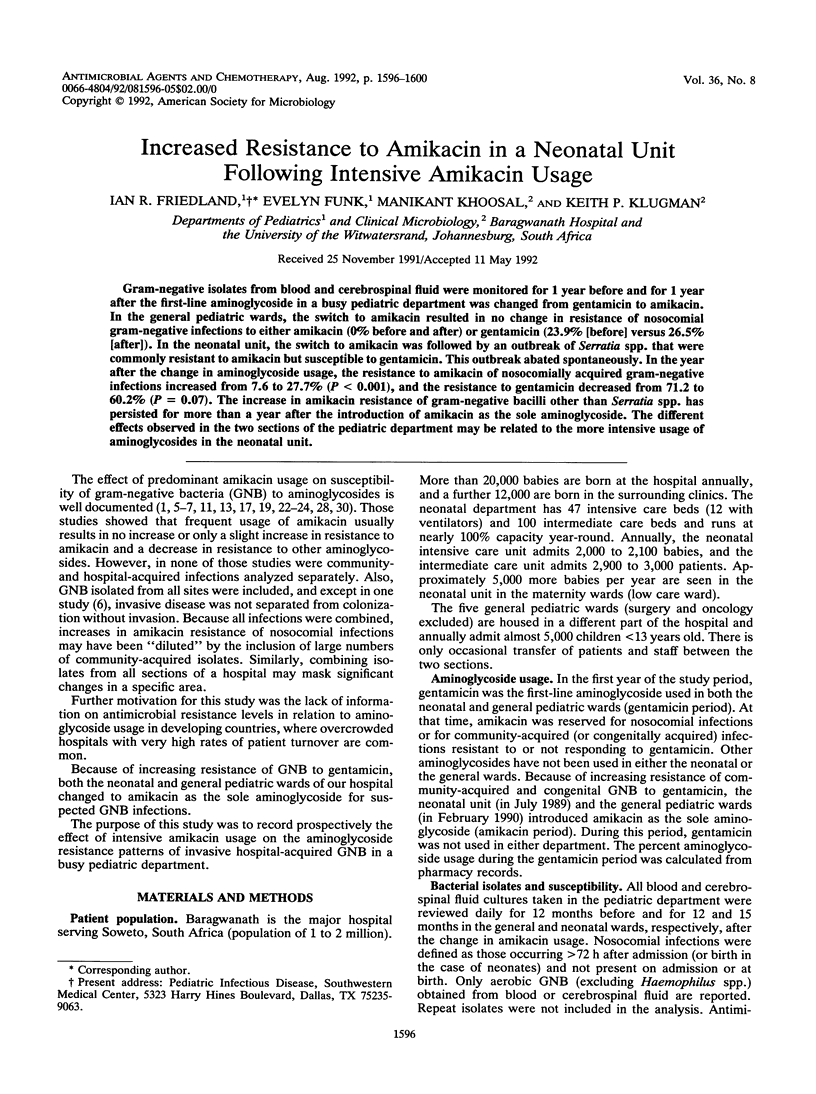
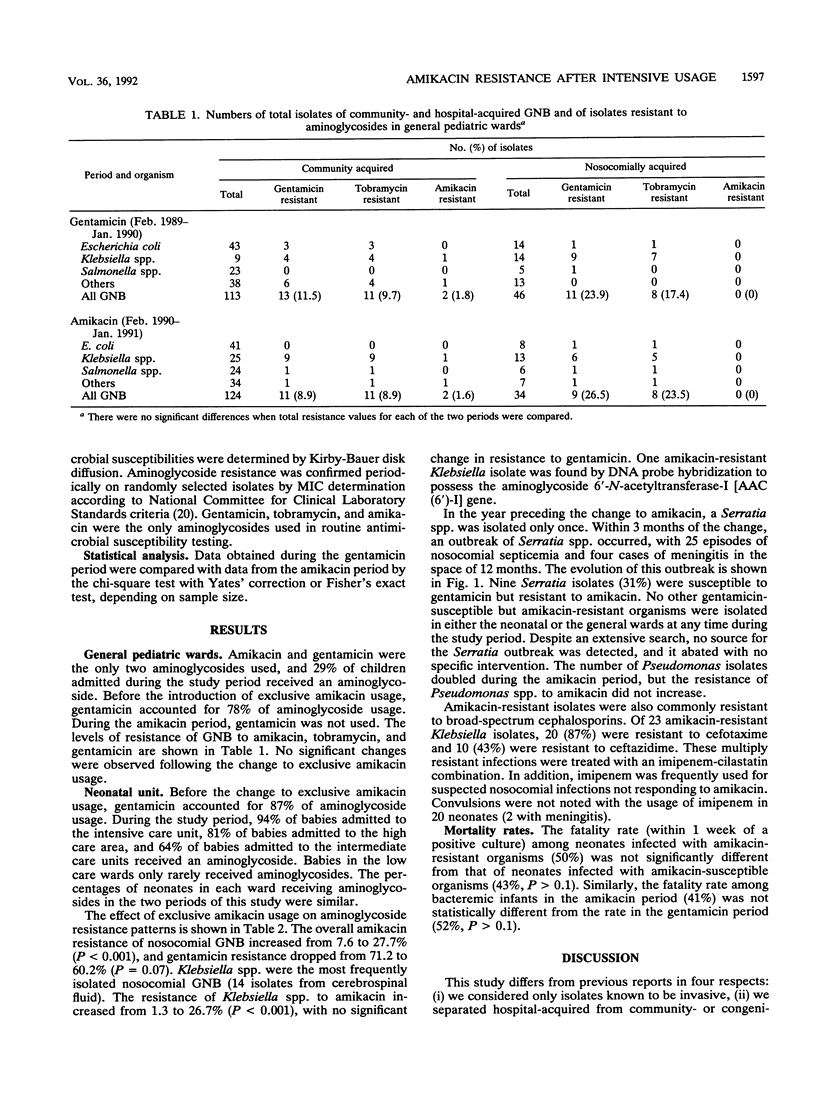
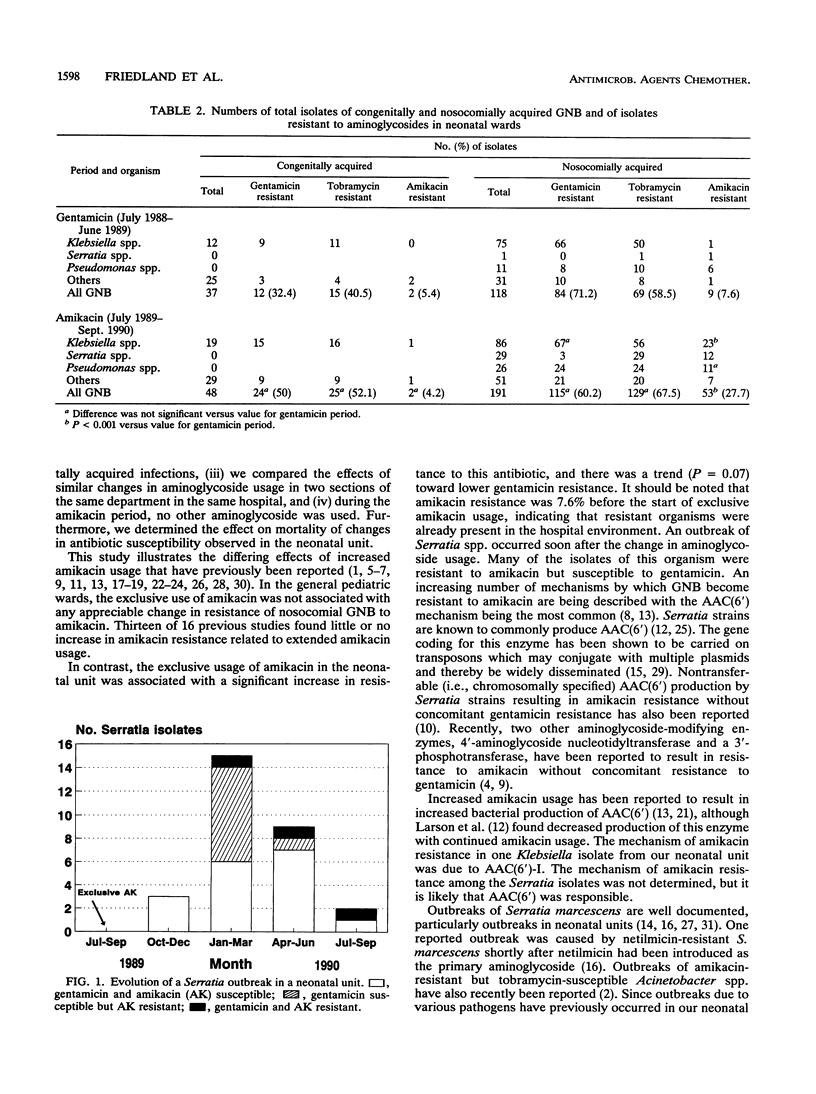
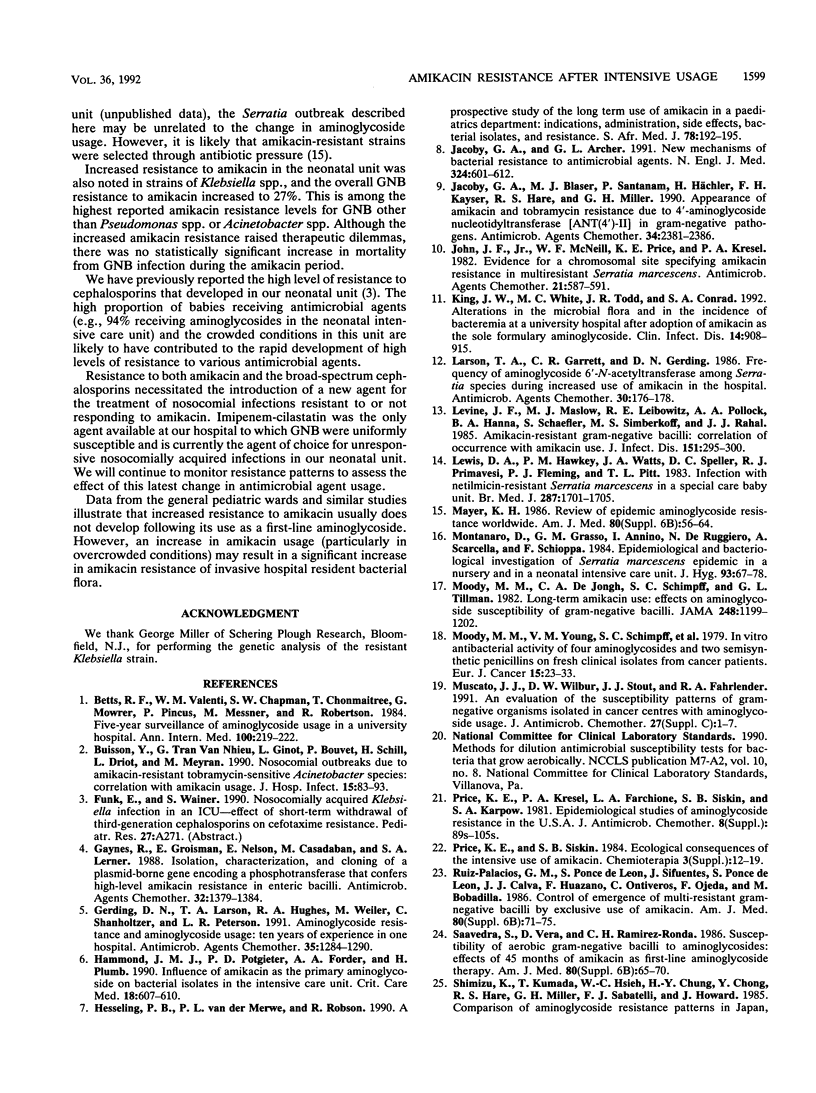
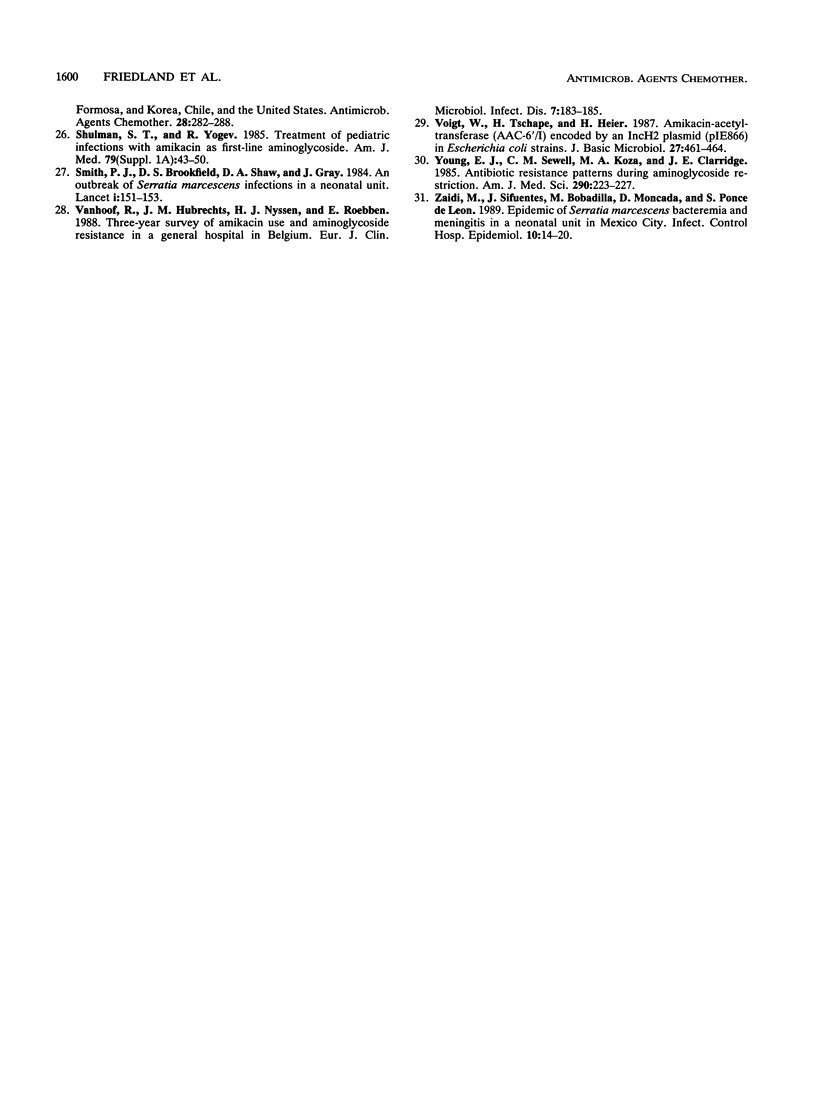
Selected References
These references are in PubMed. This may not be the complete list of references from this article.
- Betts R. F., Valenti W. M., Chapman S. W., Chonmaitree T., Mowrer G., Pincus P., Messner M., Robertson R. Five-year surveillance of aminoglycoside usage in a university hospital. Ann Intern Med. 1984 Feb;100(2):219–222. doi: 10.7326/0003-4819-100-2-219. [DOI] [PubMed] [Google Scholar]
- Buisson Y., Tran Van Nhieu G., Ginot L., Bouvet P., Schill H., Driot L., Meyran M. Nosocomial outbreaks due to amikacin-resistant tobramycin-sensitive Acinetobacter species: correlation with amikacin usage. J Hosp Infect. 1990 Jan;15(1):83–93. doi: 10.1016/0195-6701(90)90024-i. [DOI] [PubMed] [Google Scholar]
- Gaynes R., Groisman E., Nelson E., Casadaban M., Lerner S. A. Isolation, characterization, and cloning of a plasmid-borne gene encoding a phosphotransferase that confers high-level amikacin resistance in enteric bacilli. Antimicrob Agents Chemother. 1988 Sep;32(9):1379–1384. doi: 10.1128/aac.32.9.1379. [DOI] [PMC free article] [PubMed] [Google Scholar]
- Gerding D. N., Larson T. A., Hughes R. A., Weiler M., Shanholtzer C., Peterson L. R. Aminoglycoside resistance and aminoglycoside usage: ten years of experience in one hospital. Antimicrob Agents Chemother. 1991 Jul;35(7):1284–1290. doi: 10.1128/aac.35.7.1284. [DOI] [PMC free article] [PubMed] [Google Scholar]
- Hammond J. M., Potgieter P. D., Forder A. A., Plumb H. Influence of amikacin as the primary aminoglycoside on bacterial isolates in the intensive care unit. Crit Care Med. 1990 Jun;18(6):607–610. doi: 10.1097/00003246-199006000-00005. [DOI] [PubMed] [Google Scholar]
- Hesseling P. B., Mouton W. L., Henning P. A., Kirsten G. F., Spruyt L. L., Schraader E. B., Wessels G., Grassman R. A prospective study of long-term use of amikacin in a paediatrics department. Indications, administration, side-effects, bacterial isolates and resistance. S Afr Med J. 1990 Aug 18;78(4):192–195. [PubMed] [Google Scholar]
- Jacoby G. A., Archer G. L. New mechanisms of bacterial resistance to antimicrobial agents. N Engl J Med. 1991 Feb 28;324(9):601–612. doi: 10.1056/NEJM199102283240906. [DOI] [PubMed] [Google Scholar]
- Jacoby G. A., Blaser M. J., Santanam P., Hächler H., Kayser F. H., Hare R. S., Miller G. H. Appearance of amikacin and tobramycin resistance due to 4'-aminoglycoside nucleotidyltransferase [ANT(4')-II] in gram-negative pathogens. Antimicrob Agents Chemother. 1990 Dec;34(12):2381–2386. doi: 10.1128/aac.34.12.2381. [DOI] [PMC free article] [PubMed] [Google Scholar]
- John J. F., Jr, McNeill W. F., Price K. E., Kresel P. A. Evidence for a chromosomal site specifying amikacin resistance in multiresistant Serratia marcescens. Antimicrob Agents Chemother. 1982 Apr;21(4):587–591. doi: 10.1128/aac.21.4.587. [DOI] [PMC free article] [PubMed] [Google Scholar]
- King J. W., White M. C., Todd J. R., Conrad S. A. Alterations in the microbial flora and in the incidence of bacteremia at a university hospital after adoption of amikacin as the sole formulary aminoglycoside. Clin Infect Dis. 1992 Apr;14(4):908–915. doi: 10.1093/clinids/14.4.908. [DOI] [PubMed] [Google Scholar]
- Larson T. A., Garrett C. R., Gerding D. N. Frequency of aminoglycoside 6'-N-acetyltransferase among Serratia species during increased use of amikacin in the hospital. Antimicrob Agents Chemother. 1986 Jul;30(1):176–178. doi: 10.1128/aac.30.1.176. [DOI] [PMC free article] [PubMed] [Google Scholar]
- Levine J. F., Maslow M. J., Leibowitz R. E., Pollock A. A., Hanna B. A., Schaefler S., Simberkoff M. S., Rahal J. J., Jr Amikacin-resistant gram-negative bacilli: correlation of occurrence with amikacin use. J Infect Dis. 1985 Feb;151(2):295–300. doi: 10.1093/infdis/151.2.295. [DOI] [PubMed] [Google Scholar]
- Lewis D. A., Hawkey P. M., WattsJA, Speller D. C., Primavesi R. J., Fleming P. J., Pitt T. L. Infection with netilmicin resistant Serratia marcescens in a special care baby unit. Br Med J (Clin Res Ed) 1983 Dec 3;287(6406):1701–1705. doi: 10.1136/bmj.287.6406.1701. [DOI] [PMC free article] [PubMed] [Google Scholar]
- Mayer K. H. Review of epidemic aminoglycoside resistance worldwide. Am J Med. 1986 Jun 30;80(6B):56–64. doi: 10.1016/0002-9343(86)90480-8. [DOI] [PubMed] [Google Scholar]
- Montanaro D., Grasso G. M., Annino I., De Ruggiero N., Scarcella A., Schioppa F. Epidemiological and bacteriological investigation of Serratia marcescens epidemic in a nursery and in a neonatal intensive care unit. J Hyg (Lond) 1984 Aug;93(1):67–78. doi: 10.1017/s0022172400060940. [DOI] [PMC free article] [PubMed] [Google Scholar]
- Moody M. M., de Jongh C. A., Schimpff S. C., Tillman G. L. Long-term amikacin use. Effects on aminoglycoside susceptibility patterns of gram-negative bacilli. JAMA. 1982 Sep 10;248(10):1199–1202. doi: 10.1001/jama.248.10.1199. [DOI] [PubMed] [Google Scholar]
- Moody M. R., Young V. M., Schimpff S. C., Purvis D. S., Wiernik P. H. In vitro antibacterial activity of four aminoglycosides and two semisynthetic penicillins on fresh clinical isolates from cancer patients. Eur J Cancer. 1979;15 (Suppl):23–33. [PubMed] [Google Scholar]
- Muscato J. J., Wilbur D. W., Stout J. J., Fahrlender R. A. An evaluation of the susceptibility patterns of gram-negative organisms isolated in cancer centres with aminoglycoside usage. J Antimicrob Chemother. 1991 May;27 (Suppl 100):1–7. doi: 10.1093/jac/27.suppl_c.1. [DOI] [PubMed] [Google Scholar]
- Ruiz-Palacios G. M., Ponce de Leon S., Sifuentes J., Ponce de Leon S., Calva J. J., Huazano F., Ontiveros C., Ojeda F., Bobadilla M. Control of emergence of multi-resistant gram-negative bacilli by exclusive use of amikacin. Am J Med. 1986 Jun 30;80(6B):71–75. doi: 10.1016/0002-9343(86)90482-1. [DOI] [PubMed] [Google Scholar]
- Saavedra S., Vera D., Ramírez-Ronda C. H. Susceptibility of aerobic gram-negative bacilli to aminoglycosides. Effects of 45 months of amikacin as first-line aminoglycoside therapy. Am J Med. 1986 Jun 30;80(6B):65–70. doi: 10.1016/0002-9343(86)90481-x. [DOI] [PubMed] [Google Scholar]
- Shulman S. T., Yogev R. Treatment of pediatric infections with amikacin as first-line aminoglycoside. Am J Med. 1985 Jul 15;79(1A):43–50. doi: 10.1016/0002-9343(85)90190-1. [DOI] [PubMed] [Google Scholar]
- Smith P. J., Brookfield D. S., Shaw D. A., Gray J. An outbreak of Serratia marcescens infections in a neonatal unit. Lancet. 1984 Jan 21;1(8369):151–153. doi: 10.1016/s0140-6736(84)90074-6. [DOI] [PubMed] [Google Scholar]
- Vanhoof R., Hubrechts J. M., Nyssen H. J., Roebben E. Three-year survey of amikacin use and aminoglycoside resistance in a general hospital in Belgium. Eur J Clin Microbiol Infect Dis. 1988 Apr;7(2):183–185. doi: 10.1007/BF01963076. [DOI] [PubMed] [Google Scholar]
- Voigt W., Tschäpe H., Heier H. Amikacin-acetyltransferase (AAC-6'/I) encoded by an IncH2 plasmid (pIE866) in Escherichia coli strains. J Basic Microbiol. 1987;27(8):461–464. doi: 10.1002/jobm.3620270818. [DOI] [PubMed] [Google Scholar]
- Young E. J., Sewell C. M., Koza M. A., Clarridge J. E. Antibiotic resistance patterns during aminoglycoside restriction. Am J Med Sci. 1985 Dec;290(6):223–227. doi: 10.1097/00000441-198512000-00001. [DOI] [PubMed] [Google Scholar]
- Zaidi M., Sifuentes J., Bobadilla M., Moncada D., Ponce de León S. Epidemic of Serratia marcescens bacteremia and meningitis in a neonatal unit in Mexico City. Infect Control Hosp Epidemiol. 1989 Jan;10(1):14–20. doi: 10.1086/645909. [DOI] [PubMed] [Google Scholar]


